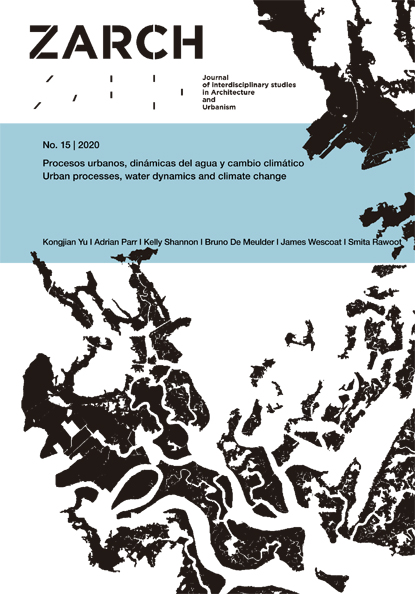HCMC: mirroring the city center, inversing contemporary logics
DOI:
https://doi.org/10.26754/ojs_zarch/zarch.2020154856Keywords:
Sài Gòn, Chợ Lớn, Thủ Thiêm, Water UrbanismAbstract
Ho Chi Minh City (HCMC), the largest agglomeration in Vietnam, is a multitude of cities and where spatial development is inherently intertwined with a continuously transforming water structure. HCMC is a relatively young city—the foundational citadel dates from the end 18th century—that nevertheless was always complex. Its original dichotomic nature, with Chinese Chợ Lớn and Vietnamese Sài Gòn, forcefully colonized and domesticated a quagmire. It eventually became colonized itself by France (formalized by the Indochina federation 1887-1954). The agglomeration subsequently underwent strong growth and transformation during the American War (1955-75), to explode even more after the (re)opening up to the market in 1986 (Đổi Mới: the change to the new). Shock and wave development (and significant disruption), hand-in-hand with forceful public intervention and laissez-faire dynamics, led to odd bedfellows—a partially planned and spontaneous urban environment, iterating between conscious design decisions anchored on territorial characteristics (predominantly defined by water structures) and generic additions regardless of the terrain, between structuring and undirected fabrics. Amidst another wave of rampant growth and expansion, the city plans to double its center eastwards across the Sài Gòn River in the water-sick districts 2, 9 and Thu Duc. This offers the occasion to boldly rethink the formation of the contemporary tropical deltaic metropolis. The article will plead for an alternative for the future development of HCMC through the elaboration of a project for the twin center of Sài Gòn, foreseen in an interfluvial land that is systematically permeated by canals, river branches, ditches, etc. The plan recognizes that the water system defines the base spatial register of the territory and intelligently anchors urban development on this register.
Downloads
References
Brocheux, Pierre; and Hémery, Daniel. 2009. Indochina: An Ambiguous Colonization, 1858-1954. Berkeley: University of California Press.
Cherry, Haydon. 2019. Down and Out in Saigon: Stories of the Poor in a Colonial City. New Haven: Yale University Press.
Doling, Tim. Icons of Old Saigon: The Belt Canal (Canal de Ceinture). https://saigoneer.com/saigon-heritage/5991-icons-of-old-saigon-the-belt-canal-canal-de-ceinture (accessed August 2020).
EIU (Economist Intelligence Unit). Global Liveability Ranking 2019. https://www.eiu.com/public/topical_report.aspx?campaignid=liveability2019 (accessed August 2020).
Gourou, Pierre. 1969. The Tropical World. Fourth edition, English. London: Longmans, Green and Co. Ltd.
GSO (General Statistics Office). Vietnamese government online portal. https://www.gso.gov.vn/default.aspx?tabid=714 (accessed August 2020).
Harms, Erik. 2016. Luxury and Rubble: Civility and Dispossession in the New Saigon. Oakland: University of California Press.
Harms, Erik. 2011. Saigon’s Edge: On the Margins of Ho Chi Minh City. Minneapolis and London: University of Minnesota Press.
HCMC Department of Planning and Architecture. 2019. Project Brief: The International Competition on Planning Concept of Highly Interactive Innovative Districts (HIID) – Ho Chi Minh City (District 2, District 9, Thủ Đức district).
Katzschner, Antje; Waibel, Michael; Schwede, Dirk; Lutz, Katzschner; Schmidt, Michael; and Storch, Harry, eds. 2016. Sustainable Ho Chi Minh City: Climate Policies for Emerging Mega Cities. Dordrecht: Springer.
Lau Tsz Long. 2016. Asian Cities Research: Saigon. https://fac.arch.hku.hk/asian-cities-research/saigon-1954-1960-15-further-points-of-study-conclusion/ (accessed August 2020).
Li Tana; and Anthony, Reid. 1993. Southern Vietnam under the Nguyen: Documents on the Economic History of Cochinchina (Dang Trong, 1602-1777). Singapore: Institute of Southeast Asian Studies.
Nghia M. Vo. 2011. Saigon: A History. Jefferson (North Carolina): McFarland & Company, Inc., Publishers.
Nguyen Thanh B.; Spencer, James H.; and Pham Tuan N. 2020.Development of the Ho Chi Minh City Megaregion in Historical Context: Doi Moi, Planning, and Real Estate. In The Routledge Handbook of Planning Megacities in the Global South, Deden Rukmana, ed., chapter 2. New York: Routledge.
Osborne, Milton E. 1969. The French Presence in Cochinchina and Cambodia: Rule and Response (1859-1905), 1997 edition. Bangkok: White Lotus Press.
Sasaki. 2020. “Thu Thiem New Urban Area,” https://www.sasaki.com/projects/thu-thiem-new-urban-area (accessed August 2020).
Taylor, Philip. 2001. Fragments of the Present: Searching for Modernity in Vietnam’s South. Honolulu: Allen & Unwin and University of Hawaii Press.
Ton Nu Quynh Tran. 2015. Les prémisses de l’urbanisation de Saigon-Ho Chi Minh-Ville: Empreintes du patrimoine culturel français sur l’evoltion urbanie locale. In Faire Savoirs no 12. HCMC: Centre d’Etudes urbanines et de Développement. https://faire-savoirs.mmsh.univ-aix.fr/Pdf/FS-12-2015-180.pdf (accessed August 2020).
Vo Hong Lien. s.d. The Making of Saigon: from the Nguyen Lords to 1954. https://www.academia.edu/7041136/The_Making_of_Saigon_from_the_Nguyen_Lords_to_1954 (accessed August 2020).
Wright, Gwendolyn. 1991. The Politics of Design in French Colonial Urbanism. Chicago and London: The University of Chicago Press.


